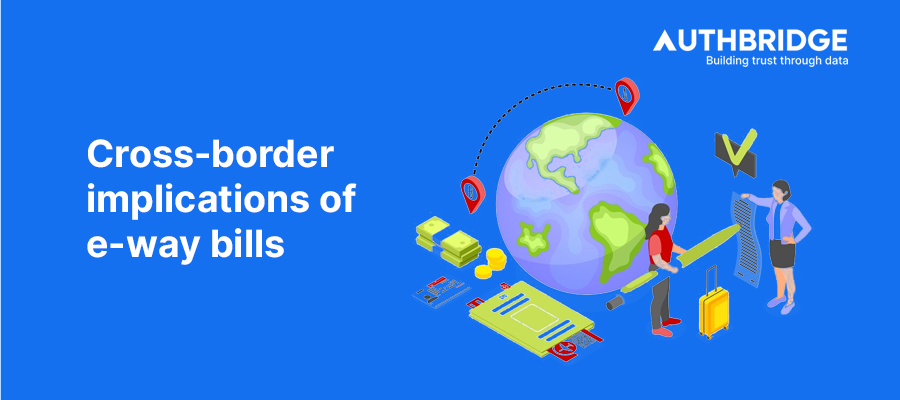Navigating Cross-Border Implications Of E-Way Bills: Challenges, Solutions, And Future Directions

The E-Way Bill system, a cornerstone of the Goods and Services Tax (GST) regime in India, has significantly streamlined the domestic movement of goods. However, its implications extend beyond national borders, affecting cross-border trade and compliance.
Overview of E-Way Bill in Cross-Border Transactions
In cross-border transactions, E-Way Bills serve as a digital interface between traders and customs authorities, facilitating smoother customs clearance and compliance with GST requirements. They ensure that goods moving across international borders are accounted for, reducing the risk of tax evasion and enhancing the efficiency of international trade.
Importance of E-Way Bills in International Trade
E-Way Bills play a crucial role in international trade by providing a transparent and verifiable mechanism to track the movement of goods. This transparency aids customs officials in verifying the authenticity of goods and their compliance with tax regulations, thereby speeding up the customs clearance process and reducing the potential for delays at border crossings.
Challenges in Cross-Border E-Way Bill Compliance
Cross-border E-Way Bill compliance introduces several challenges, stemming from the complexity of international trade regulations and the need for integration between different customs systems.
Regulatory Variations Across Borders
One of the primary challenges is the variation in regulatory requirements across different countries. Each country has its own set of rules and procedures for customs and tax compliance, making it difficult to create a one-size-fits-all E-Way Bill system that can seamlessly operate across borders.
Integration with International Customs Systems
Integrating the E-Way Bill system with the customs systems of other countries is essential for facilitating cross-border trade. This integration requires significant coordination and technological compatibility between the systems used by different countries, posing a substantial challenge.
Real-Time Tracking and Data Privacy Concerns
Ensuring real-time tracking of goods across international borders while maintaining the privacy and security of trade data is another critical challenge. The system must balance the need for transparency and monitoring with the protection of sensitive commercial information.
Technological Solutions for Cross-Border E-Way Bill Compliance
The integration of advanced technologies offers promising solutions to the challenges of cross-border E-Way Bill compliance, enhancing efficiency and security.
Integration of RFID Technology
Radio-Frequency Identification (RFID) technology enables the automatic identification and tracking of goods as they move across borders. This technology can be integrated into the E-Way Bill system to provide real-time location updates to customs officials and businesses.
Technology | Benefits |
RFID | - Real-time tracking of goods <br> - Reduced need for manual checks <br> - Enhanced security and compliance |
Use of Big Data Analytics for Monitoring and Compliance
Big data analytics can analyze vast amounts of data generated by cross-border transactions to identify patterns, trends, and potential compliance issues. This analysis can help customs authorities focus their efforts on high-risk shipments, improving the efficiency of inspections and reducing delays.
Application | Impact |
Big Data Analytics | - Identification of tax evasion patterns <br> - Optimization of customs inspection processes <br> - Enhanced accuracy in risk assessment |
E-Invoicing and Its Role in E-Way Bill Systems
E-Invoicing systems can be integrated with E-Way Bill platforms to automate the generation of bills and ensure that all transactions are accurately reflected in tax filings. This integration can simplify compliance for businesses and provide authorities with a reliable source of transaction data.
Feature | Advantages |
E-Invoicing | - Automated compliance processes <br> - Reduced paperwork and errors <br> - Improved data accuracy for customs and tax authorities |
Legal and Regulatory Framework for Cross-Border E-Way Bills
Navigating the legal and regulatory landscape is crucial for the effective implementation of cross-border E-Way Bill systems.
International Agreements and Protocols
International agreements and protocols play a vital role in harmonizing E-Way Bill requirements across borders. These agreements can provide a framework for data sharing, privacy protection, and mutual recognition of electronic documents.
Agreement | Purpose |
Bilateral Trade Agreements | Facilitate trade by recognizing each other’s E-Way Bill systems |
Data Protection Protocols | Ensure the secure and lawful handling of trade data |
Compliance with Local and International Data Protection Regulations
Ensuring compliance with data protection regulations, such as the General Data Protection Regulation (GDPR) in the European Union, is essential for protecting the privacy of businesses and individuals involved in cross-border trade.
Regulation | Requirements |
GDPR | - Consent for data processing <br> - Right to access and erase personal data <br> - Data breach notifications |
Future Directions and Innovations in Cross-Border E-Way Bill Compliance
The future of cross-border E-Way Bill compliance is likely to be shaped by ongoing technological advancements and international cooperation.
Potential Technological Advancements
Emerging technologies such as blockchain and artificial intelligence (AI) have the potential to further enhance the security, transparency, and efficiency of cross-border E-Way Bill systems.
Technology | Potential Uses |
Blockchain | - Immutable record-keeping <br> - Enhanced security and transparency |
AI | - Predictive analytics for risk assessment <br> - Automated compliance checks |
Policy Recommendations for Enhanced Compliance and Efficiency
To maximize the benefits of cross-border E-Way Bill systems, policymakers should focus on enhancing international cooperation, investing in technology infrastructure, and simplifying legal and regulatory frameworks.
Conclusion
Cross-border E-Way Bill compliance presents a complex set of challenges and opportunities. Through the integration of advanced technologies, adherence to international legal frameworks, and ongoing collaboration between customs authorities and the business community, it is possible to create a more efficient, secure, and compliant international trade environment. As the global trade landscape continues to evolve, embracing innovation and cooperation will be key to overcoming the challenges of cross-border E-Way Bill compliance.
Category

Abhinandan Banerjee
(Associate Manager - Marketing)
Abhinandan is a dynamic Product and Content Marketer, boasting over seven years of experience in crafting impactful marketing strategies across diverse environments. Known for his strategic insights, he propels digital growth and boosts brand visibility by transforming complex ideas into compelling content that inspires action.



